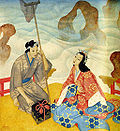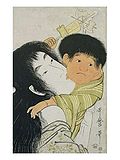- Kachi-kachi Yama
-
Kachi-Kachi Yama (Japanese: かちかち山, kachi-kachi being an onomatopoeia of the sound a fire makes and yama meaning "mountain", roughly translates to "Fire-Crackle Mountain"), is one of the few Japanese folktales in which a tanuki is the villain, rather than the boisterous, well-endowed alcoholic.
Contents
Story
The trouble-making tanuki
As the story goes, a man caught a troublesome tanuki in his fields, and tied it to a tree to kill and cook it later. When the man left for town, the tanuki cried and begged the man's wife who was making some mochi, to set him free, promising he would help her. The wife freed the animal, only to have it turn on her and kill her. The tanuki then planned a foul trick.
Using its shapeshifting abilities, the tanuki disguised itself as the wife and cooked a soup, using the dead woman's flesh. When the man came home, the tanuki served him the soup. After the meal, the tanuki reverted to its original appearance and revealed its treachery before running off and leaving the poor man in shock and grief.
Enter the rabbit
The couple had been good friends with a rabbit that lived nearby. The rabbit approached the man and told him that it would avenge his wife's death. Pretending to befriend the tanuki, the rabbit instead tortured it through various means, from dropping a bee's nest on it to 'treating' the stings with a peppery poultice that burned.
The title of the story comes from the especially painful trick that the rabbit played. While the tanuki was carrying a heavy load of kindling on his back to make a campfire for the night, he was so burdened that he did not immediately notice when the rabbit set fire to the kindling. Soon, the crackling sound reached its ears and it asked the rabbit what the sound was. "It is Kachi-Kachi Yama" the rabbit replied. "We are not far from it, so it is no surprise that you can hear it!". Eventually, the fire reached the tanuki's back, burning it badly, but without killing it.
Boat of mud
The tanuki challenged the rabbit to a life or death contest to prove who was the better creature. They were each to build a boat and race across a lake in them. The rabbit carved its boat out of a fallen tree trunk, but the foolish tanuki made a boat of mud.
The two competitors were evenly matched at first, but the tanuki's mud boat began dissolving in the middle of the lake. As the tanuki was failing in its struggle to stay afloat, the rabbit proclaimed its friendship with the human couple, and that this was the tanuki's punishment for its horrible deeds.
Variations
There are other versions that alter some details of the story, such as the severity of what the tanuki did to the woman and how the tanuki got the mud boat.
Modern-day references
Mt. Kachi Kachi and its Tenjō-Yama Park Mt. Kachi Kachi Ropeway refer to this story and have statues depicting portions of the story.
There is a railway station in Japan, called the Shikoku Tanuki Train Line, that adopts the slogan, "Our trains aren't made of mud", a direct reference to the "Kachi-Kachi Yama" tale.
In Super Mario Sunshine, in the level Noki Bay, Mario meets a Tanooki who gives free rides on mud boats—a clear reference to the boat that the tanuki in this tale used. While these boats can stay afloat, they will dissolve if they stay still for too long or if they bump into something.
External links
- "The Farmer and the Badger" translation by Yei Theodora Ozaki
Japanese folklore 
Folktales Taketori Monogatari · Urashima Tarō · Kintarō · Momotarō · Saru Kani Gassen · Tamamo-no-Mae · Issun-bōshi · Shita-kiri Suzume · Bunbuku Chagama · Yotsuya Kaidan · Hanasaka Jiisan · Kachi-kachi Yama · Tawara Tōda
Text collections Legendary creatures Categories:- Onomatopoeia
- Japanese folklore
- Japanese fairy tales
Wikimedia Foundation. 2010.
